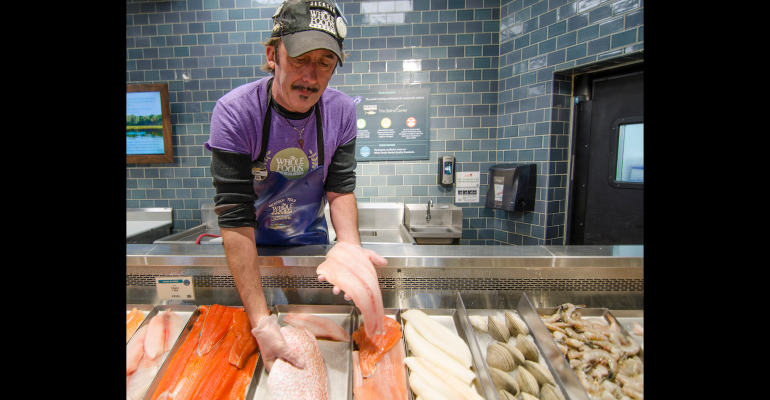TOP TAKEAWAYS
- Some 38% of seafood shoppers said their primary store for groceries differs from their primary store for seafood
- The share of seafood shoppers who identify a traditional grocery store as their primary seafood store declined to 35% in 2022, down from 37% in 2021, 42% in 2020, and 51% in 2019
- Train food retail employees has an average cost of $534, according to FMI
Educated associates who can field shopper questions and enthusiastically promote products are one of the most valuable resources you can have in the seafood department.
Yet maintaining a staff of articulate and influential employees does not come easy. Not only do retailers face the potentially large expense in time and money to properly train the workers, but operators also have the burden of retaining top-notch individuals in a sector where high turnover is becoming the norm.
Some 21% of shoppers indicate that knowledgeable counter staff impacts their decision on where to buy seafood — meaning associate expertise is a crucial consumer magnet.
About 50% of seafood shoppers said they visit a seafood counter to make a purchase, and 75% of shoppers — along with 82% of frequent customers — noted that it is “very” or “somewhat” important that the store they shop for seafood have counter staff, reports FMI—The Food Industry Association
“This tells us that a seafood counter can and does play a role for the seafood consumer either directly through services provided or by an improved perception of the retailer’s seafood,” said Rick Stein, FMI vice president of fresh foods.
Stein, who spent more than 30 years at Safeway where he was ultimately vice president of retail merchandising and marketing execution, said the ability of supervisors to engage and educate consumers is the most important aspect of a successful operation.
“We would take a talented seafood department manager and transfer them to an underperforming store, and within six months the department would have a complete turnaround,” he said. “The issue is finding outgoing, talented managers.”
Such managers are needed to serve the large base of shoppers who said they are relying on associates for product information. That includes:
- 88% of shoppers who want to learn the geographic origin of the seafood
- 88% who want to determine if the seafood is farm-raised or wild-caught
- 88% who seek sustainability details
- And 82% who desire recipe information
The seafood department, however, can be one of the hardest areas for supermarket employees to master because of the wide array of products, Stein said.
“A seafood associate must know the different species, sustainability aspects, health and well-being details, and cooking and preparation details,” he said.
An exceptional associate, he added, “goes the extra mile for the customer by supporting their cohesive meal planning needs with food pairs, food safety guidance, recipes, nutrition information, and more.”
Videos that associates can access via their smart phones and which provide details on different species and recipes while in-store can be effective training tools, Stein said.
It’s also vital that seafood department operators make workers feel valued while assuring them that they are valuable resources to shoppers, he said. The associates, for instance, can conduct in-store cooking demonstrations, have question and answer sessions with shoppers, and be spotlighted on signage, online videos, and tutorials.
“The key is recognition,” Stein said. “Acknowledging talent and rewarding them with kudos and compliments is a very effective strategy.”
Transforming seafood associates into experts is a major endeavor because of the complexity of seafood, which necessitates knowing about the unique characteristics of a multitude of species, Stein said.
While ongoing workforce education is essential, it also can be expensive. FMI said there is an average cost of $534 to train each food retail employee.
Nevertheless, about 92% of food retailers operate in-house training and development programs while approximately 63% also purchase programs from third-party vendors, FMI said.
Retailers, meanwhile, also must pinpoint or develop qualified replacements when they promote top talent out of the department, Stein added.
Leveraging such associates is crucial as many consumers will switch stores to have the best purchasing experience. FMI reported that 38% of seafood shoppers said their primary store for groceries differs from their primary store for seafood.
The share of seafood shoppers who identify a traditional grocery store as their primary seafood store declined to 35% in 2022, down from 37% in 2021, 42% in 2020, and 51% in 2019, FMI said.
In addition, 25% of consumers reported that supercenters or discount outlets are their primary store for seafood buying, while 12% name club stores, and 28% said they use a mix of other types of stores, including seafood specialty, limited assortment, natural, ethnic, and online retailers.
Thirty-five percent of shoppers list good/friendly service and 13% name receiving seafood purchasing advice as factors in selecting a primary seafood store.
“A seafood counter can and does play a role for the seafood consumer either directly through services provided or by improving perception of the retailer’s seafood,” FMI said.





